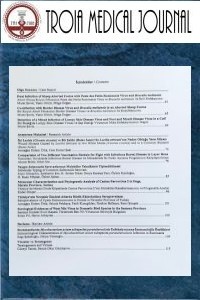Olası Q ateşi:Dört olgunun sunumu
Atipik pnömoni, Coxiella burnetii, Perikardit, Q ateşi
Probable Q fever: presentation of four cases
Atypical pneumonia, Coxiella burnetii, Pericarditis, Q fever,
___
- 1. Marrie TJ. Coxiella burnetii (Q fever). In: Mandell GL, Bennet JE, Dolin R, eds. Principles and Infectious Diseases. Fifth ed. Philadelphia: Churchill Livingstone, 2000, pp: 2043-50.
- 2. Kılıç S, Çelebi B. Türkiye’de C.burnetii’nin epidemiyolojisi. Türk Hijyen ve Deneysel Biyoloji Dergisi 2008;65(3): 1-31.
- 3. Topçu AW, Söyletir G, Doğanay M(editörler); Q Ateşi. In: Mamıkoğlu L. Enfeksiyon Hastalıkları ve Mikrobiyolojisi. 2017, Nobel Tıp Kitabevleri, İstanbul, s: 940-7
- 4. Maurin M, Raoult D. Q fever. Clin Microbiol Rev 1999;12: 518-53.
- 5. McQuiston JH, Childs JE. Q fever in humans and animals in the United States. Vector Borne and Zoonotic Diseases 2002; 2: 179-91.
- 6. Gikas A, Kokkini S, Tsioutis C. Q fever: clinical manifestations and treatment Expert Rev. Anti Infect. Ther. 2010;8: 529-39.
- 7. Behymer D, Riemann HP. Zoonosis update, Coxiella burnetii infection. JAVMA 1989; 194: 764-7.
- 8. Kilic S, Yilmaz GR, Komiya T, et al. Prevalence of Coxiella burnetii antibodies in blood donors in Ankara, Central Anatolia, Turkey. New Microbiologica. 2008;31: 527-34.
- 9. Yeşilyurt M, Kılıç S, Gürsoy B, et al. Q ateşi ile ilişkili iki akut hepatit olgusu. Mikrobiyoloji Bülteni. 2012; 46(3): 480-7.
- 10. Sırmatel Bucuk P. , Sırmatel F. Unutulan Bir Zoonotik Hastalık: Q Ateşi. Abant Medical Journal. 2022; 11(1): 132-42.
- 11. Wegdam-Blans MCA, Wielders CCH, Meekelenkamp J, et al. Evaluation of Commonly Used Serological Tests for Detection of Coxiella burnetii Antibodies in Well-Defined Acute and Follow-Up Sera. Clin Vaccine Immunol. 2012;19(7): 1110-5.
- 12. Alkan S. Çanakkale ilindeki Q ateşi olgularının retrospektif olarak değerlendirilmesi. The Medical Journal of Mustafa Kemal University. 2022; 13(47): 343-8.
- 13. Beaman, M. H., and J. Hung. 1989. Pericarditis associated with tick-borne Q fever. Aust. N. Z. J. Med. 19: 254–6.
- 14. Caughey, J. E. 1977. Pleuropericardial lesion in Q fever. Br. Med. J. 1:1447.
- 15. Raoult, D., Tissot-Dupont, H., Foucault, C., Gouvernet, J., Fournier, P. E., Bernit, E., ... & Weiller, P. J. (2000). Q fever 1985-1998. Clinical and epidemiologic features of 1,383 infections. Medicine, 79(2): 109-23.
- 16. Kaya Ş. Coxiella (Q ateşi): Tanı. Parlak M, editör. Coxiella (Q Ateşi). 1. Baskı. Ankara: Türkiye Klinikleri; 2021: 10-4.
- 17. T.C. Sağlık Bakanlığı Ulusal Mikrobiyoloji Standartları, Q Ateşinin Mikrobiyolojik Tanısı B-MT-22 (2015): 11
- 18. Coşkunlar M. Ankara’da takip edilen 50 Q humması vakası üzerine klinik bir inceleme. Anadolu Kliniği. 1948; 15(4): 144-7.
- 19. Payzın S. Orta Anadolu’da bir köyde Q humması salgını. Türk Hijyen ve Deneysel Biyoloji Dergisi. 1948; 8(1): 116-25.
- ISSN: 2630-6107
- Yayın Aralığı: Yılda 3 Sayı
- Başlangıç: 2019
- Yayıncı: Çanakkale Onsekiz Mart Üniversitesi
Beste AKMAN, Orkun KAVANİ, Yağmur YÜCEL, Memduh Salih ÇİFCİBAŞI, Rabia Selina HAL, Coşkun BAKAR
Olası Q ateşi:Dört olgunun sunumu
Burak TURAÇ, Mehmet ÇELİK, Mehmet Reşat CEYLAN, Abdülkerim ÖZÇELİK
Aynı aileden eş zamanlı yatırılan iki atipik bruselloz olgusu
Işıl Deniz ALIRAVCI, Anıl AKÇA, Servan VURUCU, Tuba ELTİMUR KARATOPRAK, Cihan YÜKSEL
Long/post COVID’de anosminin nörolojik semptomlar içindeki sıklığı ve yaşam kalitesine etkisi
Sudomotor disfonksiyonu olan diyabetik hastalarda ayak bakım eğitimi etkinliğinin değerlendirilmesi
Emine SEVİNÇ POSTACI, Şule ALPAR ECEVİT
Pestisitlerin DNA affinite düzeylerinin incelenmesi: docking analiz sonuçlari
Merve ARAS, Özlem YAYINTAŞ, Sibel OYMAK YALÇIN
Pandemi döneminin sınıf içi soru sorma tekniklerine etkisi
Gamze ÇAN, Murat TEKİN, Mehmet Ali ÇAN, Çetin TORAMAN
Serebrovasküler olay ile prezente olan COVID-19 vakası
Fatma Yekta URKMEZ, Sevil ALKAN ÇEVİKER
